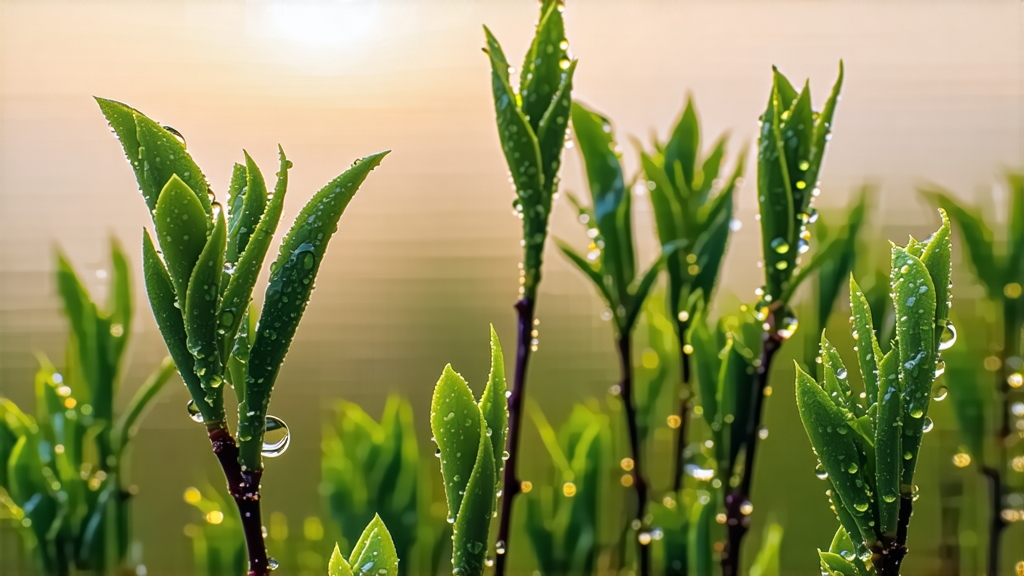
Nestled between the mist-veiled hills of Dongting Mountain and the shimmering expanse of Lake Tai in Jiangsu Province, Biluochun—literally “Green Snail Spring”—has captivated Chinese tea lovers since the late Ming dynasty. Legend claims a tea picker tucked fresh leaves between her breasts to free both hands; the warmth released an intoxicating perfume that startled a passing monk, who christened the tea “Frightening Fragrance.” The Kangxi Emperor, tasting it two centuries later, found the name inelegant and rechristened it Biluochun for its tight spiral shape and spring harvest. Thus an imperial tribute tea was born, carried south to north in bamboo-lined chests sealed with lotus leaves to preserve every whisper of its fruity bouquet.
Botanically, Biluochun belongs to the small-leaf Camellia sinensis var. sinensis. Within this single cultivar, micro-terroirs create subtle clans: the original “Dongting West Mountain” strain grows on weathered granite slopes where morning lake mist refracts sunlight into soft, cool wavelengths; “Dongting East Mountain” bushes, planted among peach, plum and loquat trees, absorb floral volatiles that later reappear in the cup. A newer “Yunnan Biluochun” exists, yet purists dismiss it as geographic impostor, insisting only lake-cradled Jiangsu buds possess the signature mineral snap.
Plucking begins when two leaves and a bud are still shorter than a fingernail—usually the first ten days after Qingming festival. Pickers work barefoot to feel the humus-rich soil, believing earth-energy travels upward into tender shoots. Leaves are deposited in shallow bamboo trays lined with mosquito-net silk; any depth beyond three centimeters risks bruising and premature oxidation. Within two hours the harvest must reach the village workshop, a cedar-plank room whose windows are draped with wet hemp to maintain 75 % humidity and 22 °C.
Withering is almost theatrical: trays are slid onto rafters above simmering vats of local spring water, allowing gentle steam to wilt the cells for exactly 38 minutes. Once the leaves lose 15 % moisture they are ready for the most critical step—hand-firing in a wok whose surface temperature dances between 180 °C and 90 °C within sixty seconds. A master maker, barefoot to sense micro-vibrations, tosses 250 grams of leaves with bamboo-tined tweezers in a figure-eight motion. Fingers never touch metal; skin oils would dull the brilliant jade color. The leaves curl like snail shells as enzymes deactivate and amino acids condense into chestnut and orchid notes. After six minutes the wok is raked with a cypress branch, releasing a puff of apricot-scented vapor that locals call “the mountain’s sigh.” Final drying occurs on horse-hair sieves set over charcoal embers of peach wood, imparting a whisper of stone-fruit smoke that disappears into the green.
To brew Biluochun abroad, choose glass or celadon rather than porcelain; transparency showcases the silver-tipped spirals unfurling like miniature ferns. Begin with 80 °C water—cooler temperatures preserve the tea’s volatile esters, while hotter water extracts bitter catechins. Measure three grams per 150 milliliters, or roughly a heaping teaspoon. Gently pour water along the vessel wall to create a thermal cushion, then pause five seconds and decant the first infusion; this “awakening rinse” removes surface dust and initiates leaf respiration. Subsequent steeps last 25, 35 and 50 seconds, each revealing a different stratum: the opening cup offers bright peas and Meyer lemon; the second, honeyed loquat and wet slate; the third, a lingering note of fresh almond milk. Fourth and fifth infusions can be extended to one minute, yielding lighter yet still aromatic liquor that pairs elegantly with raw oysters or fresh goat cheese.
Professional cupping follows a stricter choreography. Five grams are placed in a 110-milliliter white porcelain gaiwan. Water at 85 °C is poured to the brim; the lid is slid to create a two-millimeter vent. After three minutes the liquor is decanted into a tasting bowl and the wet leaves are raked onto a black ceramic plate. Inspect color first: top-grade Biluochun steeps into a pale “young bamboo” green with platinum edges. Inhale the gaiwan lid: aroma should suggest white peach, freesia and a trace of